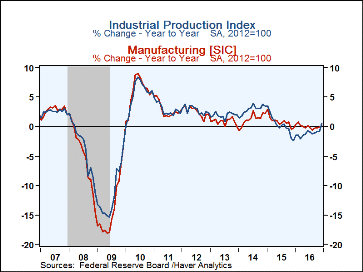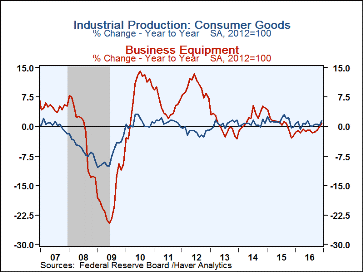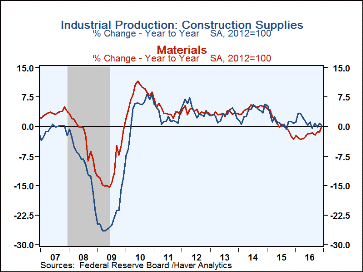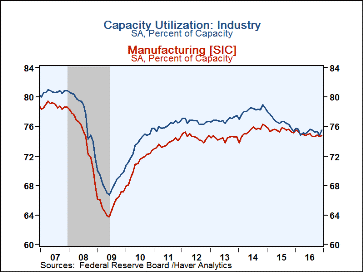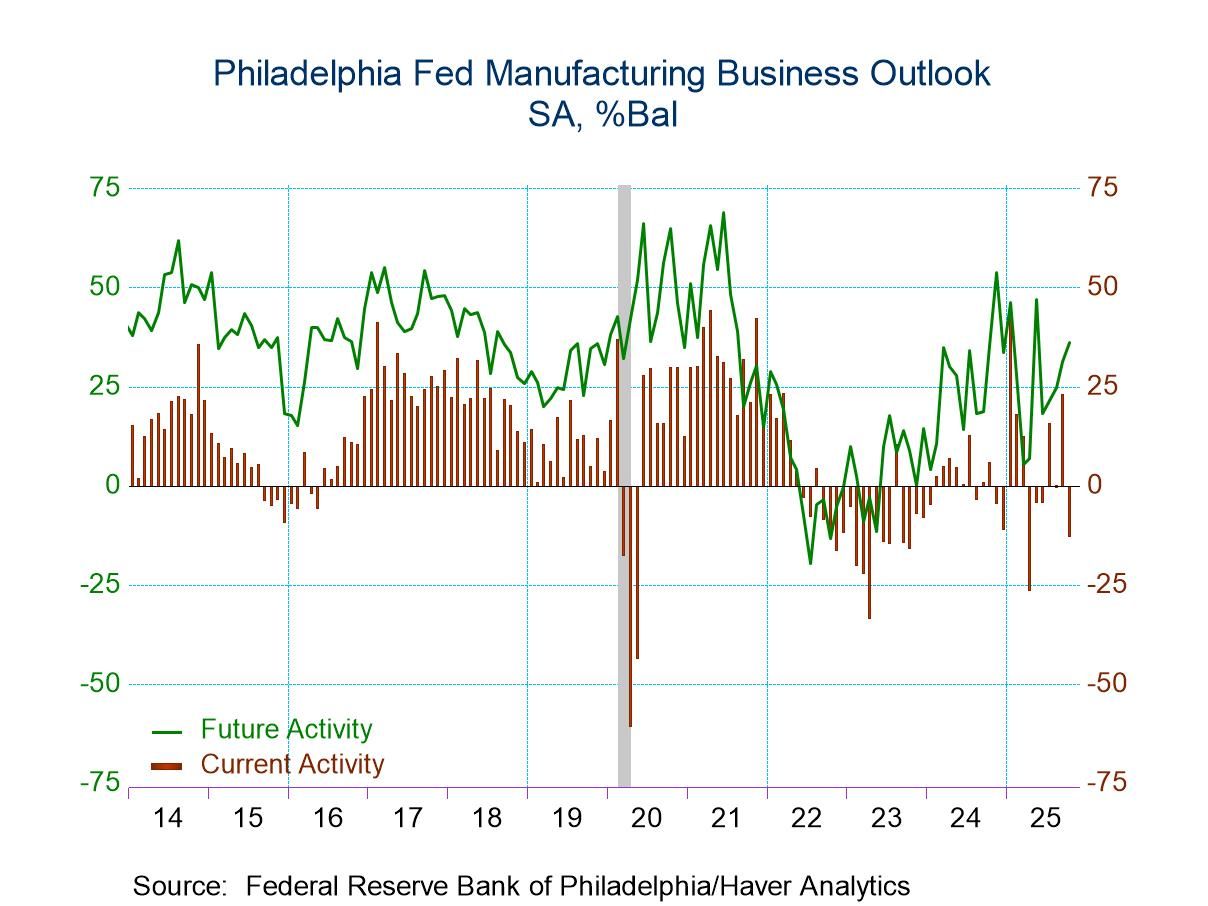 Global| Jan 18 2017
Global| Jan 18 2017U.S. Industrial Production Rebounds
by:Tom Moeller
|in:Economy in Brief
Summary
During all of 2016, industrial production improved 0.5%. In December alone, industrial output increased 0.8% following a 0.7% November decline, revised from -0.4%. The latest reading exceeded expectations for a 0.6% increase in the [...]
During all of 2016, industrial production improved 0.5%. In December alone, industrial output increased 0.8% following a 0.7% November decline, revised from -0.4%. The latest reading exceeded expectations for a 0.6% increase in the Action Economics Forecast Survey.
Much of the weakness in output last year was due to a 2.7% December-to-December decline in mining production. During all of 2016, mining output fell 9.0% on average from 2015. Utilities production made up for some of this weakness with a 6.6% rebound in December, a 6.2% increase y/y.
Factory sector production gained 0.2% last month (0.2% y/y) following a 0.1% slip. Production was unchanged for the full year. Consumer goods production rebounded 1.1% (1.6% y/y) and made up a 1.0% fall in November. In the durable goods sector, auto production recovered 2.1% (8.6% y/y) and recouped November's decline. Computers and video & audio equipment production fell by 1.0% (+2.1% y/y) after a 0.2% dip. Furniture & appliance production fell 0.4% ( 1.0% y/y) following a 0.8% rise. In the nondurable goods area, clothing output improved 0.2% (-3.7% y/y), but chemical production declined 1.0% (-1.8% y/y). Paper output eased 0.2% (+1.8% y/y). In the capital goods sector, production rebounded 0.7% (0.8% y/y) after a 0.6% decline. Transit equipment production remained unchanged (-1.7% y/y), but information processing equipment strengthened 1.4% (4.6% y/y). Construction supplies production eased 0.3% (+0.3% y/y).
In the materials sector, a 1.0% increase in output (0.1% y/y) reflected a 0.2% rise (-0.1% y/y) in durables and a 0.5% decline (-0.2% y/y) in nondurables. Energy materials production rebounded 3.1% (0.8% y/y) following a 2.7% decline.
In the special industrial output groupings, computers, communications equipment & semiconductor output rose 0.3% (3.0% y/y). Computer & peripheral equipment output rebounded 2.4% (+19.2% y/y) after a 3.7% decline, but communications equipment output remained steady (3.8% y/y). Overall factory sector production excluding both the high-tech and automotive sectors was unchanged (-0.5% y/y) following a 0.1% uptick.
Capacity utilization increased to 75.5%, but fell to 75.3% for the year from 76.7% in 2015. Factory sector utilization was little changed m/m at 74.8%, but remained below the 2014 peak of 76.3%.
Industrial production and capacity data are included in Haver's USECON database, with additional detail in the IP database. The expectations figure is in the AS1REPNA database.
The Fed's latest Beige Book covering regional economic conditions can be found here.
| Industrial Production (SA, % Change) | Dec | Nov | Oct | Dec Y/Y | 2016 | 2015 | 2014 |
|---|---|---|---|---|---|---|---|
| Total Output | 0.8 | -0.7 | 0.2 | 0.5 | -1.0 | 0.3 | 2.9 |
| Manufacturing | 0.2 | -0.1 | 0.3 | 0.2 | 0.0 | 0.8 | 1.3 |
| Consumer Goods | 1.1 | -1.0 | -0.2 | 1.6 | 0.7 | 1.4 | 0.7 |
| Business Equipment | 0.7 | -0.7 | 0.1 | 0.8 | -0.9 | 0.7 | 2.4 |
| Construction Supplies | -0.3 | 1.0 | 0.9 | 0.3 | 1.2 | 1.5 | 3.7 |
| Materials | 1.0 | -0.9 | 0.5 | 0.1 | -2.0 | 0.5 | 4.7 |
| Utilities | 6.6 | -4.6 | -2.7 | 6.2 | -0.5 | -0.7 | 1.3 |
| Mining | 0.0 | -0.7 | 3.5 | -2.7 | -9.0 | -1.8 | 11.0 |
| Capacity Utilization (%) | 75.5 | 74.9 | 75.4 | 75.4 | 75.3 | 76.7 | 78.2 |
| Manufacturing | 74.8 | 74.7 | 74.9 | 75.2 | 75.0 | 75.5 | 75.4 |
Tom Moeller
AuthorMore in Author Profile »Prior to joining Haver Analytics in 2000, Mr. Moeller worked as the Economist at Chancellor Capital Management from 1985 to 1999. There, he developed comprehensive economic forecasts and interpreted economic data for equity and fixed income portfolio managers. Also at Chancellor, Mr. Moeller worked as an equity analyst and was responsible for researching and rating companies in the economically sensitive automobile and housing industries for investment in Chancellor’s equity portfolio. Prior to joining Chancellor, Mr. Moeller was an Economist at Citibank from 1979 to 1984. He also analyzed pricing behavior in the metals industry for the Council on Wage and Price Stability in Washington, D.C. In 1999, Mr. Moeller received the award for most accurate forecast from the Forecasters' Club of New York. From 1990 to 1992 he was President of the New York Association for Business Economists. Mr. Moeller earned an M.B.A. in Finance from Fordham University, where he graduated in 1987. He holds a Bachelor of Arts in Economics from George Washington University.


